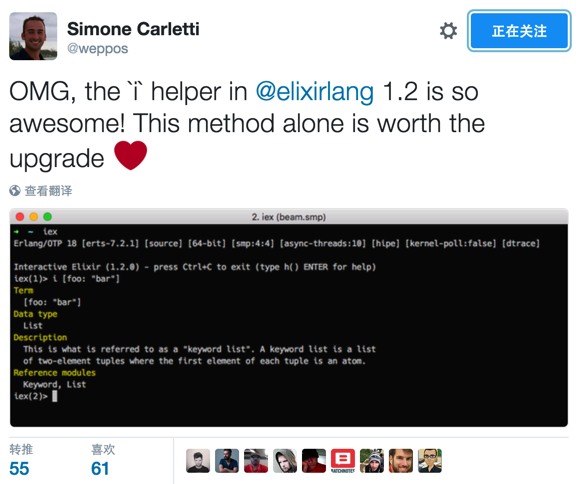
elixir在1.2后增加了一个新的特性i helper. 在iex shell中使用i可以查看任意数据的数据类型和详细描述
#查看变量描述 iex(1)> i {:test, "That sounds great"} Term {:test, "That sounds great"} Data type Tuple Reference modules Tuple #查看Module描述(有点类似于Erlang的lists:module_info) iex(2)> i List Term List Data type Atom Module bytecode usr/local/Cellar/elixir/1.2.0/bin/../lib/elixir/ebin/Elixir.List.beam Source private/tmp/elixir20160101-48495-1fg1arr/elixir-1.2.0/lib/elixir/lib/list.ex Version [322093417650371381585336045669056703278] Compile time 2016-1-1 11:57:45 Compile options [:debug_info] Description Use h(List) to access its documentation. Call List.module_info() to access metadata. Raw representation :"Elixir.List" Reference modules Module, Atom
来看看这么神奇的功能是怎么实现的吧~
@doc """ Prints information about the given data type. """ def i(term) do info = ["Term": inspect(term)] ++ IEx.Info.info(term) for {subject, info} <- info do info = info |> to_string() |> String.strip() |> String.replace(" ", " ") IO.puts IEx.color(:eval_result, to_string(subject)) IO.puts IEx.color(:eval_info, " #{info}") end dont_display_result end
可以看出它只是把IEx.info.info的结果打出来,我们再看看它发生了什么?
defprotocol IEx.Info do @fallback_to_any true @spec info(term) :: [{atom, String.t}] def info(term) end defimpl IEx.Info, for: Tuple do def info(_tuple) do ["Data type": "Tuple", "Reference modules": "Tuple"] end end
它是一个protocol,在这个文件中把elixir的基本类型都实现了一次,它会返回一个keyword list, 所以我们才能看到,那么如果我们试试自己定义?
iex(3)> defmodule User do …(3)> defstruct name: "John", age: 25 …(3)> @type t :: %User{name: String.t, age: non_neg_integer} …(3)> end
因为在info.ex中已处理struct的类型, 如果我们现在直接i的结果它是
iex(4)> i %User{} Term %User{age: 25, name: "John"} Data type User Description This is a struct. Structs are maps with a __struct__ key. Reference modules User, Map
接下来, 我们来自定义看看
iex(5)> defimpl IEx.Info, for: User do …(5)> def info(item) do …(5)> ["Data type": User, "Description": "The customer is god, pleasure they", "Reference": "blablabla..."] …(5)> end …(5)> end iex(6)> i %User{} Term %User{age: 25, name: "John"} Data type Elixir.User Description The customer is god, pleasure they Reference blablabla...
成功!
官方文档: http://elixir-lang.org/docs/stable/iex/IEx.Helpers.html#i/1
彩蛋:
有没有看到我们输入i得到的结果,只是把格式用有颜色的格式打印出来,但是确没有看到返回值被打印出来。。。
它的结果无论如何都打印不出来滴。因为它调用了
IEx.dont_display_result
在 evaluator.ex 里面:
unless result == IEx.dont_display_result, do: io_inspect(result)
if my fingers were erlang processes
